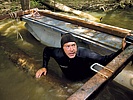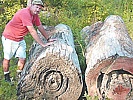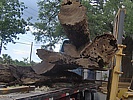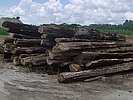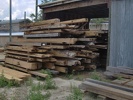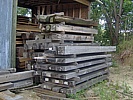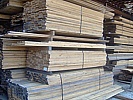About Wood Louvers
About Cypress | Q&A | Photos
Wood Louvers offer a natural look to Sun Control Systems. We prefer Western Red Cedar and Cypress as our woods of choice.. We know how to fabricate, seal and if needed, stain them for the best exterior performance. In both cases, we recommend you let them weather naturally, but if staining or painting are necessary, that will take some research depending on the outcome preferred.
| Cypress | West. Red Cedar | |
| Specific Gravity | .46 | .32 |
| Density (lbs/ft cubed) | 31.4 | 22.4 |
| Static Bending-Dry Lumber | ||
| Modulus of rupture (lbs/in squared) | 10,600 | 7,500 |
| Modulus of elasticity (millions lbs/in squared) | 1.44 | 1.11 |
| Work to maximum load (in-lbs/ft cubed) | 8.2 | 5.8 |
| Impact Bending-Dry Lumber | ||
| Height of drop causing failure (in) | 24 | 17 |
| Compression parallel to grain-Dry Lumber | ||
| Maximum crushing strength (lbs/in squared) | 6,360 | 4,560 |
| Compression perpendicular to grain-Dry Lumber | ||
| Fiber stress at proportional limit (lbs/in squared) | 730 | 460 |
| Tension perpendicular to the grain-Dry Lumber | ||
| Maximum tensile strength (lbs/in squared) | 270 | 220 |
| Shear parallel to grain-Dry Lumber | ||
| Maximum shearing strength (lbs/in squared) | 1000 | 990 |
| Side Hardness (lbs) | 510 | 350 |
| Flame Spread Rating | 145-150 | 70 |
North American Cypress (Taxodium distichum), grows in wet, swampy areas along the Eastern Coast from Delaware to Florida and west along the Gulf to the Mexican border in Texas and north up the Mississippi River Valley. This water-loving tree grows best in the swampy areas of Florida and the lower Mississippi river and can reach heights of up to 145 feet. Common names for cypress include: Baldcypress, bald cypress, cypress, swamp cypress, southern cypress, red cypress, yellow cypress, white cypress, tidewater cypress, gulf cypress, black cypress, cow cypress.
Cypress trees are one of two American conifers (softwoods) that shed foliage in the fall like hardwoods. Although a softwood, it has traditionally been grouped and manufactured with hardwoods because it grows alongside hardwoods and is even graded by the rules of the National Hardwood Lumber Association.
Cypress has many exterior and interior uses. Cypress heartwood is extremely decay and insect resistant due to the naturally occurring preservative known as cypressine. It is an ideal choice for house construction, docks, beams, decks, flooring, paneling and siding. Cypress can also be milled to make doors, windows, rails, and even caskets. The ancient Egyptians used cypress to produce the pharaoh's caskets, and in the Middle Ages, craftsmen used it to carve enormous cathedral doors.
One Cypress grade that is particularly popular for interior paneling is Pecky cypress. Although the exact cause is unknown, Pecky occurs when the wood is attacked by fungus, resulting in lens-shaped pockets throughout the wood. When finally cut for paneling, it yields an attractive three dimensional look unlike any other wood. Studies have not revealed the exact origin of the fungus or why it attacks only certain trees. Even though Pecky Cypress is considered an independent grade, it is not as readily available as the Selects and Commons and therefore offers a special opportunity to present a truly unique rustic appearance.
| Pecky Cypress | Common Cypress |
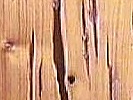 |
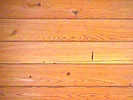 |
| Heavy Pecky Cypress | Select Cypress |
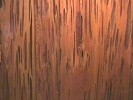 |
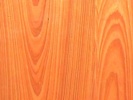 |
Cypress is as beautiful and distinctive on the inside as it is durable on the outside. Due to the slow growth, the rings are much closer than in most wood species. These close rings tend to make cypress more energy efficient, and decreased shrinkage makes it more durable and stable. In its natural state, the wood is a pale honey color that features light streaks on a darker background, and unsealed, weathers to an even gray on the surface. Even though it tested as a high paint retainer, most prefer the wood unpainted, as it will last for hundreds of years in this state with minimal checking or warping.
Supply of Cypress is tied directly to the weather. Because much of the cypress is found in swampy areas, it is hard to get to, sometimes requiring helicopters for removal. Statistics show that growth of cypress is greater than removal.
Q: What are the cypress grades?
A: Cypress grades have been set by the SCMA in cooperation with the National Hardwood Lumber Association. They are outlined in the Standard Specifications for Grades of Southern Cypress, available from the SCMA. Grades are according to use, manufacture, size and moisture content. A brief summary of grades include (for pictures of grades see About Cypress):
Select- The best face is mostly clear of knots and defects. Wider widths allow only a few defects. Narrower widths clear of knots and other defects.
#2 Common - The best face will contain sound encased knots that do not detract from the workability or appearance of the wood. The reverse side admits imperfections that do not distract from the utility and serviceability of this general purpose grade.
Pecky - Contains pockets of varying length and depth on the best face of the board. This is a grade unique to cypress that in many ways defies description but leaves a lasting impression.
Q: What dimensions are available?
A: Cypress comes in 4/4" to 16/4" thickness, 4"-12" even widths, and 6'-16' even lengths.
Q: Is cypress a softwood or hardwood?
A: Cypress is technically a softwood, but it is graded as a hardwood according to the National Hardwood Lumber Association's rules. Although it has needlelike leaves typical of softwoods, cypress loses its needles during the autumn and winter.
Q: Where does cypress grow?
A: Cypress grows in the swamp areas of the Southeast from the Carolinas to Florida and along the Gulf of Mexico into Texas. Because it is found in remote, swampy areas, some of the harvesting is done with helicopters.
Q: Is cypress the same as tidewater red cypress?
A: Cypress is the common name for bald cypress (Taxodium distichtim) but it is also known as southern cypress, red cypress, yellow cypress, white cypress and, commercially, tidewater red cypress and gulf cypress. Red cypress is often used to describe the coastal cypress and yellow cypress to designate inland grown.
Q: Is cypress a new lumber product? I've never heard of it.
A: Cypress has been used for thousands of years, according to historians. Ancient Egyptians crafted mummy cases of cypress and medieval craftsmen used cypress for carved cathedral doors. Because it became difficult to harvest, little was available a few years ago, but modern methods now assure a steady, plentiful supply.
Q: Where can cypress be used?
A: Cypress is a versatile wood with many uses. It comes rough sawn or smooth in a variety of siding patterns and takes nearly every surface treatment available. The wood is ideal for decking, fences and other outdoor uses as well as siding, millwork and paneling.
Q: Is cypress durable?
A: Cypress has a natural preservative oil known as cypressene which gives the heartwood resistance to insects and decay. With a suitable surface treatment, cypress generally has superior durability, holding paint well and resisting weather.
Q: Does cypress have any special characteristics?
A: Cypress has a rich color ranging from off-white to deep red and a handsome grain which makes it a natural for interior paneling. Pecky cypress, which has unique three dimensional markings, has an especially attractive rustic appearance. Used with a protective coating, cypress acquires a beautiful natural finish.
Q: Is cypress difficult to work?
A: Cypress when well seasoned (dry) has little tendency to warp, twist or cup and has good nail holding ability. Because it is sold in random lengths of 6 to 16 feet and widths of 4 to 12 inches, cypress requires fewer cuts and joints at the job site. Cypress works well with both hand and power tools. Even though it is a resinous wood, it glues well. Cypress planes easily, resists warping, sands easily, and readily accepts finishes.
Q: How does Cypress compare with Pine and Cedar?
A: CYPRESS is as beautiful and distinctive on the inside as it is durable on the outside. Bald Cypress (referred to as Southern Cypress by the Southern Cypress Manufacturers Association) grows in swampy regions. Due to the slow growth, the rings are much closer than in most wood species. These close rings tend to make cypress more energy efficient, and decreased shrinkage makes it more durable and stable. In its natural state, the wood is a pale honey color and unsealed, weathers to an even gray on the surface (natural color can easily be restored if desired.)
PINE grows quickly, which results in wider banding, more porous substance. This means treatment is required to prevent rot and insect attack. This porous wood stains through the surface and with treatment becomes somewhat darker. Untreated material will stain deep toward the core leaving permanent marks and becoming subject to mold and rot. For this reason, natural weathering is not recommended.
CEDAR is a darker wood with heavy odor (check for allergic sensitivity). A lighter and porous wood, it weathers and absorbs treatment resulting in darker tones.
| Good | Better | Best | |
| Insects: | Pine | Cedar | Cypress |
| Decay/Rot: | Pine | Cedar | Cypress |
| Weathering: | Pine | Cedar | Cypress |
| Durability: | Pine | Cedar | Cypress |
| Weight: | Cypress | Pine | Cedar |
| Shrink/Warp: | Pine | Cedar | Cypress |
| Check/Cracks: | Cedar | Pine | Cypress |
| Cost: | Cedar | Cypress | Pine |
| Strength: | Cedar | Cypress | Pine |
| Insulation: | (a factor of dryness, shrink/warp & seal) | ||
| Stability: | Pine | Cedar | Cypress |
Q: How do I convert Board Ft to Lineal Ft?
A: Lineal Ft measures how long a given board is, while Board Ft measures the volume of a given board. A 10 Ft 1x6 is measured as 10 Lineal Ft (LFt) and as 5 Board Ft (BFt).
To calculate LFt from BFt, use this formula:
(# of BFt x 12)/(width x thickness)
If you need 1000 BFt of 1x8, then:
(1000 BFt x 12) / (1 x 8) = 1500 LFt
To calculate how many BFt you would need from Lft:
(# of LFt x (Width x Thickness)) / 12.
Q: How do I find out how many LFt I need to cover a certain area?
A: To find out how many LFt you need to cover a given area:
(# of SqFt to cover x 12) / (Face Width of the pattern)
If you want to know how many LFt of 1x6 T&G V-Joint (remember that the face of 1x6 T&G V-Joint is 5 1/8") you need to cover 2000 SqFt of wall, then:
(2000 x 12) / (5.125) = 4682 LFt
If you are using two different widths (1x8 and 1x4 T&G V-Joint for example) on the surface, add the faces together and treat them as one face.
We suggest you add 10%-15% waste to be safe.
Gallery
|
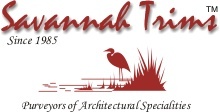
Phone (561) 293-3959
Fax (561) 656-2599
Toll-Free (888) 640-0850
E-Mail: Click Here
